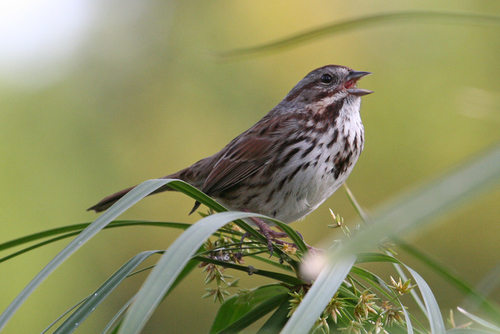
Song Sparrow
The Song Sparrow (Melospiza melodia) is a widespread and highly adaptable passerine bird native to North America. It is renowned for its complex and variable songs, which differ significantly across its vast range. The species plays a crucial role in seed dispersal and insect control within its various habitats. While not currently considered globally threatened, some regional populations face pressures from habitat loss and degradation. The Song Sparrow has been extensively studied, making it a model species for understanding avian behavior, ecology, and evolution.
11-18 cm
Length
18-25 cm
Wingspan
Least Concern
Conservation Status
Distribution
The Song Sparrow has one of the widest distributions of any North American passerine. It ranges from Alaska and Canada south through the United States to central Mexico. Some northern populations are migratory, moving south for the winter, while others are resident year-round. They exhibit a wide altitudinal range, from sea level to over 3,000 meters.
Lifespan
The oldest recorded Song Sparrow in the wild lived over 11 years. However, the average lifespan is likely much shorter, around 2-3 years.
Song Sparrow's Habitat
Habitat Types
Open, shrubby habitats, Marshes, Woodland edges, Agricultural fields, Suburban gardens, Riparian corridors
Climate Zones
Temperate, Subarctic, Boreal, Subtropical
Adaptations
Their adaptable nature allows them to thrive in diverse environments. Populations in salt marshes, for example, have developed larger bills, potentially aiding in consuming larger, harder seeds found in those habitats. Their varied diet also contributes to their success in different environments.
Variations
The Song Sparrow is one of the most polytypic bird species in North America, with over 50 recognized subspecies. These subspecies vary considerably in plumage coloration, size, and song characteristics. Island populations, such as those on the Aleutian Islands, often show marked differences from mainland populations.
Appearance
Breeding Plumage
Plumage is generally similar year-round, although it may be slightly brighter during the breeding season.
Seasonal Feather Changes
Seasonal variation is subtle, with plumage appearing fresher and more vibrant after molting.
Sex Based Plumage Differences
Males and females have very similar plumage, making them difficult to distinguish visually. Subtle differences may be present in the intensity of streaking or breast spot size.
Notable Features
Streaked brown upperparts, Whitish underparts with heavy, dark streaking, Prominent dark central breast spot (malar stripe), Long, rounded tail, Brown crown with a pale median stripe
Diet and Feeding
Primary Foods
Seeds, Insects, Small fruits, Invertebrates
Foraging Behavior
Song Sparrows primarily forage on the ground, hopping and scratching among leaf litter and low vegetation. They also glean insects from foliage and occasionally catch flying insects. They may visit bird feeders, especially in winter.
Specializations
Their relatively heavy bill is well-suited for cracking seeds. Their foraging behavior is adaptable, allowing them to exploit a variety of food sources.
Seasonal Diet Variations
Their diet shifts seasonally. During the breeding season, insects and other invertebrates form a major part of their diet, providing protein for growing chicks. In winter, they rely more heavily on seeds.
Behavior
Social Structure
Song Sparrows are generally solitary or found in pairs during the breeding season. Outside of breeding, they may form small, loose flocks, especially at feeding sites.
Communication
Complex songs used for territorial defense and mate attraction, Various call notes, including chips, trills, and buzzes, Visual displays, such as wing-flicking and tail-pumping
Migration
Northern populations are migratory, with birds moving south to the southern United States and Mexico for the winter. The timing and distance of migration vary depending on the population. Migration is triggered by a combination of factors, including day length and food availability.
Territorial or Group Behaviors
Males are highly territorial during the breeding season, defending their territories against rivals with song and aggressive displays. Territories are established in areas with suitable nesting sites and food resources.
Conservation
Threats
Habitat loss and degradation due to agriculture and urbanization, Pesticide use, Collisions with buildings and vehicles, Predation by domestic cats, Climate change (potential shifts in range and breeding phenology)
Protection Programs
Habitat restoration and conservation efforts, Monitoring programs to track population trends, Public awareness campaigns to reduce threats
Local National Laws
Protected under the Migratory Bird Treaty Act in the United States and similar legislation in Canada and Mexico.
Population Trend
Stable
Population Estimates
The global population is estimated to be around 130 million individuals.
Interesting Facts
Song Sparrows learn their songs from their fathers and neighbors.
This leads to regional dialects, with songs varying significantly across their range.
They can have over 20 different song types in their repertoire.
Although individual males typically sing only a subset of these.
The Song Sparrow is one of the most-studied bird species in North America.
Its abundance and adaptability make it an excellent subject for research on avian biology.
Females prefer males with larger song repertoires.
This suggests that song complexity is an indicator of male quality.
Some Song Sparrow populations are surprisingly tolerant of human disturbance.
They can often be found nesting in suburban gardens and parks.
Faqs about Song Sparrow
What does a Song Sparrow sound like?
The song is a variable series of notes, often starting with a few clear whistles followed by a trill or buzz. It's often described as sounding like 'maids-maids-maids-put-on-your-tea-kettle-ettle-ettle.'
What do Song Sparrows eat?
They eat a mix of seeds, insects, and small fruits, depending on the season. They primarily forage on the ground.
Where do Song Sparrows build their nests?
They typically build cup-shaped nests on the ground, well-hidden among vegetation, or low in shrubs.
Are Song Sparrows aggressive?
Males are territorial during the breeding season and will defend their territory against other males. However, they are not generally aggressive towards humans.
How can I attract Song Sparrows to my yard?
Provide a source of fresh water, plant native shrubs and grasses, and offer seed feeders, especially during the winter. Avoid using pesticides.
Copyright @ Nature Style Limited. All Rights Reserved.
 English
English